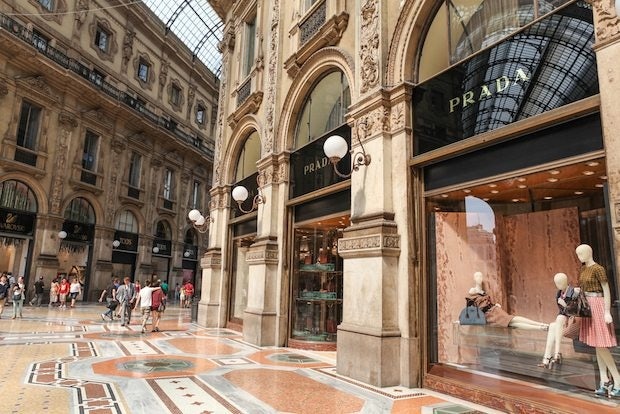
A Prada store in Milan. (Shutterstock)
2014 proved to be a challenging year for Italy. According to Global Blue, luxury spending in Italy dropped 3 percent last year, due in large part to the country’s exposure to Russian tourism. Political turmoil and an ensuing devaluation of the Ruble caused a significant decrease in the number of Russian visitors to Italy, with spending by Russians plummeting 16 percent.
However, Chinese tourists proved a bright spot in Italy last year, with arrivals increasing 11 percent—lower than other leading nations, but still a positive increase. Meanwhile, spending by Chinese tourists in Italy rose 13 percent in 2014, meaning that Chinese travelers now account for 25 percent of all luxury spending in Italy, more than any other country. But amid this momentum, what does 2015 portend? And is Italy–and Italian firms–ready?
Ready or Not#
Over one million Chinese tourists are expected to visit Italy for this year’s Milan Expo, at which China’s pavilion is the largest, and the number of businesses represented the greatest, among all nationalities. This will bring a tremendous influx of visitors, which, if estimates prove correct, will provide a significant boost to the luxury and tourism industries alike.
In addition, one important development will impact Chinese tourism to Italy. The significant drop in the euro since its high in May 2014 will make an Italian holiday 20 percent cheaper. As a result, tour operators in China are already reporting a strong increase in demand for European destinations. However, as often is the case in economics, currency devaluations only provide temporary boosts, meaning that Italy (and its companies) cannot rely on a weak euro alone if it hopes for long-term gain from the worldwide boom in Chinese overseas travel.
On an official level, Italy has improved some practices to stimulate Chinese tourism. In particular, its visa application process has been streamlined and the country—along with France—now has one of the most “user-friendly” procedures in the Schengen zone.
Yet several factors constrain Italy’s growth. The first regards connectivity. Italy currently only has 28 direct flights per week to China, far less than France and Germany. Alitalia’s recent announcement to reopen flights to Shanghai (three times per week) is perhaps “too little, too late” for a rapidly growing market.
Second, despite some improvement, in general “China-readiness” remains low among Italian firms. A lack of Chinese translations, Mandarin-speaking salespeople, and amenities (wifi in airports, retail locations and boutiques) considered basic elsewhere, provide a sub-optimal environment for Chinese tourists.
What can Italian luxury firms do?#
C-level luxury executives need to understand that Chinese tourists don’t just provide one-time sales to Italian cash registers; they are a crucial component of brand building. Italian boutiques are a valuable touchpoint for customers to best experience a brand and its heritage. Understanding that this customer is global (and visits to boutiques in Milan will eventually impact the success of a brand in China as well) is critical.
Most Italian luxury firms today take a passive and purely tactical approach to tourist engagement. Their efforts (if any) tend to focus on influencing purchases locally via tour guide commissions and/or advertising in local travel publications. Yet this also needs to be complemented by other efforts. Engaging with consumers in China, before they depart, via social media, forums and blogs can be a powerful way to engage the traveling consumer. This is particularly important given the shift toward individual travel, where research and booking is done online. Unfortunately, most luxury firms see these activities as tasks for the domestic Chinese market. With Chinese consumers now making an estimated 80 percent of luxury purchases abroad, this strategy clearly demands a rethink.
Secondly, Italian luxury firms must learn to embrace technology to improve the retail experience and improve global CRM. Chinese consumers are decidedly younger and more connected than Italy understands. Providing in-store WiFi and offering more opportunities to engage with the brand via social platforms like WeChat (which virtually every Chinese visitor will use before, during and after her travels) can significantly impact sales and loyalty. Most firms confuse powerful tools like WeChat as promotional, “push” communication tools relegated to PR firms and deployed for the China market. In fact, platforms like WeChat should be leveraged in Italian boutiques as well, as they are very effective ways to engage with traveling tourists for CRM and even m-commerce.
Whether they’re ready or not, Italian luxury firms will most certainly see more Chinese shoppers in the years ahead. Successful firms will need to adopt a strategic view of tourism in the context of overall global China market development. By devising a well-organized strategy and deploying relevant tools and technology, Italian firms stand only to win by engaging–and delighting–the Chinese consumer, whether she is in Beijing or Milan.
Philip Guarino is the Europe director at China Luxury Advisors.